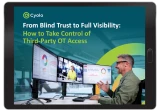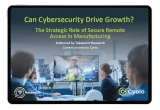Table of Contents
Where to Start Your Secure Access Journey
Keeping your organization secure requires a strategic approach to mitigate potential risks. All data that a company produces or stores is important, but clearly some assets are more sensitive or valuable than other. Similarly, all users who access corporate systems pose a certain level of risk, but only some users have the potential to cause catastrophic damage to the business.
When it comes to deploying secure remote access across an enterprise, Cyolo recommends a phased rollout that prioritizes ensuring security for privileged access scenarios first. Exactly who is deemed to be a privileged user will vary from organization to organization, but it is a category that includes far more user groups than just the IT admins traditionally considered to need privileged access. The three groups examined in this blog often require privileged access and therefore pose higher than average risk. Securing these groups, in order of risk level, is the first step in the journey toward a significantly improved security posture.
Third-Party Vendors and Contractors
Businesses today frequently rely on support from third-party partners, vendors, contractors, or other service providers. In order to perform the jobs they were hired for, these users must be connected to internal environments and applications – even though doing so is risky for the organization.
Third-party users are not direct employees who work on managed, corporate-owned devices, and they are likely unfamiliar with the company’s security policies or best practices. They are also difficult to monitor and control with most secure access tools. Even when they have nothing but good intentions, third parties are more likely to put sensitive data at risk. According to a 2021 Ponemon report, “59% of organizations suffered a breach caused by a third party.”
Organizations should prioritize securing third-party access for several compelling reasons:
Data Protection: Third-party vendors often have access to sensitive company data, intellectual property, customer information, and critical assets. Failing to secure their access can lead to data breaches, which can result in significant financial losses, legal consequences, and damage to the organization’s reputation.
Compliance Requirements: Many industries are subject to strict regulatory requirements regarding data protection and privacy. Organizations must ensure that their third-party vendors adhere to these regulations to avoid non-compliance penalties and legal complications.
Supply Chain Risks: Organizations rely on third-party vendors for various products and services, leaving their supply chain vulnerable. A security breach in a vendor’s system can disrupt operations, lead to product delays, and impact the organization’s bottom line.
Cybersecurity Threats: Cybersecurity threats, such as malware, ransomware, and phishing attacks, are evolving and becoming more sophisticated. Third-party vendors with weak security practices can serve as entry points for attackers seeking to compromise the organization’s network.
Business Continuity: Disruptions caused by security incidents involving third-party vendors can lead to downtime and disruption of operations. Prioritizing vendor security helps maintain business continuity, whereas not doing so presents potential safety risks and severe financial losses. This is especially true in the case of industrial enterprises, which were to found by a 2024 Ponemon report (conducted in collaboration with Cyolo) to allow OT environment access for an average of 77 third-party vendors.
OT Systems and Operators
OT environments, ranging from manufacturing plants to oil refineries to underground mines, support machinery, critical infrastructure, and real physical processes. The innate sensitivity of OT systems, coupled with the potentially disastrous consequences of a cyberattack against such a system, means that workers who access OT environments, and in particular third-party contractors who do so, should be considered privileged, and ensuring their secure access should be prioritized.
Key reasons to include OT systems and operators in the early stages your secure remote access deployment project include:
Avoiding Operational Disruptions: As already mentioned, OT systems control and manage critical industrial processes, machinery, and infrastructure. Security breaches or disruptions to these systems can lead to downtime, production delays, and equipment damage. Prioritizing OT security helps prevent operational disruptions that can result in significant financial losses and even physical damage.
Safety Concerns: In many industries, OT systems directly impact safety, not only for workers but also for surrounding communities and the wider environment. Compromised OT systems can lead to accidents, safety violations, and environmental disasters. Ensuring the security of OT systems helps protect lives and the environment.
Protecting Intellectual Property: OT environments frequently contain proprietary technology, manufacturing processes, and intellectual property vital to maintaining the organization’s competitive advantage. Securing access to OT systems helps prevent unauthorized access and industrial espionage, safeguarding valuable trade secrets and protecting the business.
Compliance Requirements: Industrial enterprises face some of the most robust regional and industry-specific compliance mandates. From ISA/IEC 62443 to NERC CIP to the soon-to-be implemented NIS2 Directive, organizations that operate industrial control systems (ICS) and other OT risk non-compliance and serious fines if they cannot demonstrate they are following cybersecurity best practices and enforcing secure access to OT environments.
Preventing Financial Losses: Security incidents involving OT systems can result in substantial financial losses, including the cost of recovering from the breach, repairing or replacing damaged equipment, and potential legal liabilities. Prioritizing OT security is a cost-effective measure to mitigate these risks.
Mitigating Cybersecurity Threats: OT systems are being increasingly targeted by sophisticated cybercriminals and nation-state actors. Breaches can lead to data theft, industrial sabotage, or crippling ransomware attacks. By implementing robust security protocols, organizations can defend themselves against these threats and reduce vulnerabilities.
Remote Workers
Remote work is the new normal for many organizations. Today, employees simply expect to conveniently access work resources from wherever they happen to be. The problem is that the most commonly used tool for enabling remote access, the virtual private networks (VPNs), was never intended to support such widespread use. The flaws of the VPN, in terms of both security and efficiency, have been plainly demonstrated over the past several years. Remote workers who continue to connect via VPNs or other insecure access solutions pose a substantial risk to their organizations.
Reasons to prioritize implementing secure access for remote employees include:
Data Protection: Remote workers often access and handle sensitive company data, customer information, and proprietary resources from outside the corporate network. Ensuring their security helps prevent data breaches and unauthorized access to critical information or applications.
Cybersecurity Threats: Remote employees are frequently targeted by phishing, ransomware, and other cyberattacks. By prioritizing the security of their remote workforce, organizations can reduce the risk of malware or bad actors infiltrating their network through compromised endpoints.
Compliance Requirements: Many industries have regulatory requirements that demand the protection of sensitive data, regardless of where it is accessed or stored. Enforcing secure access for remote workers helps organizations meet compliance and avoid potential legal consequences and fines.
Business Continuity: Remote work has become integral to business continuity plans. Ensuring the security of remote employees’ devices and connections helps maintain operations during crises, such as natural disasters or pandemics, when employees may be forced to work remotely.
Reputation and Trust: A security incident involving remote employees can damage an organization’s reputation and erode trust among partners and customers. Demonstrating a commitment to remote employee security helps uphold trust and credibility in the eyes of important stakeholders.
Conclusion
Safeguarding your organizational assets is an ongoing endeavor best achieved in partnership with a vendor that can help identify the privileged users and assets that will give you the biggest ROI from your secure access implementation project. The Cyolo advanced secure remote access solution is purpose-built to enable third-party users, OT operators, remote workers, and other privileged user groups securely and seamlessly access the resources they need to work. Together, we can build the right strategy to strengthen your organization's security posture and protect its most valuable assets.

Jennifer Tullman-Botzer
Author
Jennifer Tullman-Botzer has over a decade of experience in cybersecurity marketing and is as tired as you are of hackers-in-hoodies stock images. She joined Cyolo in 2021 and currently serves as Head of Content. Prior to Cyolo, Jennifer worked in a variety of marketing roles at IBM Security. She lives in Tel Aviv, Israel.

Subscribe to Our Newsletter







